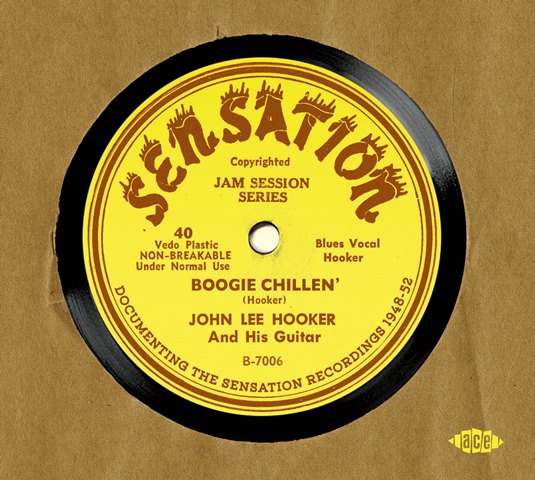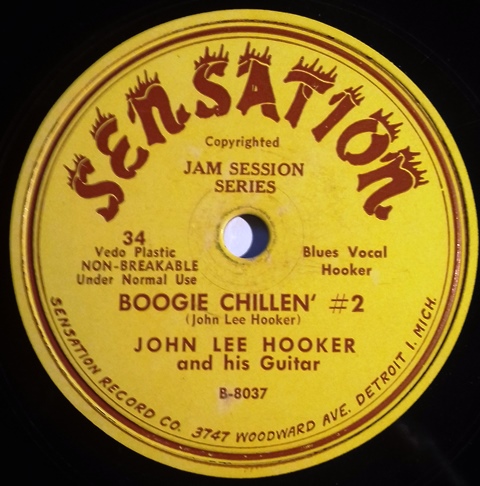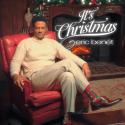John Lee Hooker’s recording career began on Friday 3 September 1948. He’d attracted the attention of the Kiev-born Bernard Besman, who was in Detroit after his family moved there in 1926 following five years in London’s East End. By the 1940s Besman, who played piano, was a veteran of dance bands and also worked as a booker. In 1946 he began working with records. At the time of encountering Hooker, Besman co-owned Sensation Records. Its early, pre-Hooker, signings included The Todd Rhodes Orchestra, Lord Nelson and his Boppers and the Doc Wiley Trio – who variously traded in boogie, jazz and R&B.
Hooker was another transplant to Detroit. Born in Mississippi, he had lived in Memphis and arrived in Detroit in 1943. He played live, but earned a wage at the Ford factory and then at a steel mill. Before meeting Besman, a local record shop owner arranged for him to record demos.
 The most immediate result of the session with Besman booked at Detroit’s United Sound studios was the release of the "Boogie Chillen'" / "Sally May" single, which Sensation leased to California’s Modern label. The single would, in 1949, become a best seller. Modern went on to issue other tracks from the session on subsequent singles: “Crawlin' King Snake”, “Drifting From Door to Door”, “Hobo Blues” and “Howlin' Wolf”. Unsurprisingly, in the wake of Hooker's success, further tracks and alternate versions from the September 1948 session surfaced on a haphazard series of albums.
The most immediate result of the session with Besman booked at Detroit’s United Sound studios was the release of the "Boogie Chillen'" / "Sally May" single, which Sensation leased to California’s Modern label. The single would, in 1949, become a best seller. Modern went on to issue other tracks from the session on subsequent singles: “Crawlin' King Snake”, “Drifting From Door to Door”, “Hobo Blues” and “Howlin' Wolf”. Unsurprisingly, in the wake of Hooker's success, further tracks and alternate versions from the September 1948 session surfaced on a haphazard series of albums.
That Friday at United Sound was epochal. “Boogie Chillen'" became one of the standard candidates for the slippery role of the first rock ’n roll record. “Crawlin' King Snake” would live forever and has been covered endlessly. The first 13 tracks on the important 3-CD set Documenting The Sensation Recordings 1948–1952 bring together everything which is now known to survive from the session (the cover image, pictured above, is a fun mock-up of what a Sensation release of "Boogie Chillen'" would have looked like). Astoundingly, amongst this baker’s dozen is a trio of previously unheard performances: three radically different takes of “War is Over (Goodbye California)”.
Documenting The Sensation Recordings 1948–1952 is, manifestly, a major release. It collects for the first time everything Hooker recorded with Besman – the period before the singer-guitarist-writer’s hook-up with Chess Records. Hooker’s attitude to contracts was loose, and his pseudonymous Besman-era recordings for other labels made as Delta John, Texas Slim and Johnny Williams are absent as they had nothing to with Sensation. A Besman-produced Little Eddie Kirkland single with John Lee Hooker on guitar and vocal is included,
 This collection is issued by Ace Records, who bought the Sensation catalogue from Besman (he died in 2003). Ace also has the rights for Besman’s licensee Modern. Documenting The Sensation Recordings is the result of a recent, thorough examination of what came with the two acquisitions. The audio sources include newly discovered acetates and previously undocumented tracks lurking on master tapes. The sound quality is, maybe surprisingly, great. Nothing evidences digital over processing. The well-annotated booklet inside the slipcase with the 3-CD digi-pack includes illustrations of the acetates, tape boxes and studio logs, a sessionography as well as commentaries by Dr Wayne Goins of Kansas State University and Peter Guralnick.
This collection is issued by Ace Records, who bought the Sensation catalogue from Besman (he died in 2003). Ace also has the rights for Besman’s licensee Modern. Documenting The Sensation Recordings is the result of a recent, thorough examination of what came with the two acquisitions. The audio sources include newly discovered acetates and previously undocumented tracks lurking on master tapes. The sound quality is, maybe surprisingly, great. Nothing evidences digital over processing. The well-annotated booklet inside the slipcase with the 3-CD digi-pack includes illustrations of the acetates, tape boxes and studio logs, a sessionography as well as commentaries by Dr Wayne Goins of Kansas State University and Peter Guralnick.
Overall, there are 82 tracks. Nineteen of them are previously unreleased versions. Eleven sessions are heard, sequenced in chronological order. Hooker’s final studio session with Besman was held on 22 May 1952. Incredibly, what’s heard from the date includes "That's All Right Boogie", a track with Kirkland which has never previously surfaced.
Especially interesting is a 10-track session from 28 April 1950. By this time, thanks to “Boogie Chillen'", Hooker was nationally known. Five of the tracks are versions of “Boogie Chillen' #2”, a cut Sensation itself issued and maybe asked Hooker to create – doubtless in an attempt catch up with Modern making hay with “Boogie Chillen'”. Of the versions of “Boogie Chillen' #2”, Take 1 has never been heard before. Two takes appear for the first time in an unedited, extended form.
 Considering that “Boogie Chillen' #2” is a livelier sibling of “Boogie Chillen'", it’s unsurprising Hooker messes around from one take to the next. The third version has a different, more boompity-boomp rhythm than its predecessors. The final run-through incorporates unique guitar flurries and ostensibly off-the-cuff lyrics. Hooker wasn’t playing the same thing twice. Commercial success had not turned him into a human jukebox.
Considering that “Boogie Chillen' #2” is a livelier sibling of “Boogie Chillen'", it’s unsurprising Hooker messes around from one take to the next. The third version has a different, more boompity-boomp rhythm than its predecessors. The final run-through incorporates unique guitar flurries and ostensibly off-the-cuff lyrics. Hooker wasn’t playing the same thing twice. Commercial success had not turned him into a human jukebox.
Also from this session, “Roll ’n Roll” (another previously unheard take) quirkily re-uses the “Boogie Chillen'" rhythm and raises the question of what level of preparation went into each studio visit. Next up, “Rollin' Blues” is pretty much the same song as “Roll ’n Roll”. Again, off-the-cuff appears right.
It’s exciting to hear John Lee Hooker finding and feeling his way. Although assured, he wasn’t paying heed to exactitude. Besman wasn’t setting templates. Also, while everything collected does not strictly foretell what lay ahead – these aren’t musical tea leaves which can be read to tell Hooker’s future – it feeds into it. Laying-out this opening chapter of Hooker's recording career so boldly tells a previously untold history. The great music is reason enough reason to get this, but anyone with the barest interest in the development of blues and how it was co-opted by white pop needs Documenting The Sensation Recordings 1948–1952.
- Next Week: Bonus-stuffed reissue of the Brian Wilson and Van Dyke Parks album Orange Crate Art
- More reissue reviews on theartsdesk
- Kieron Tyler’s website















Add comment